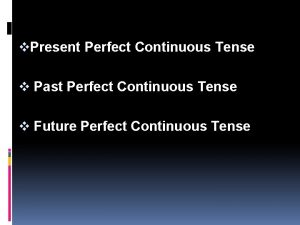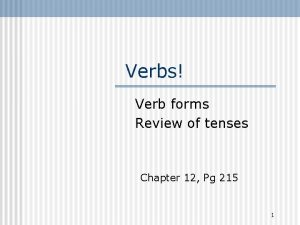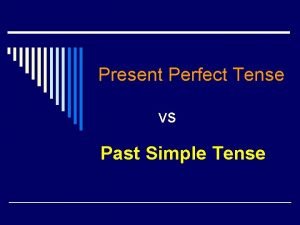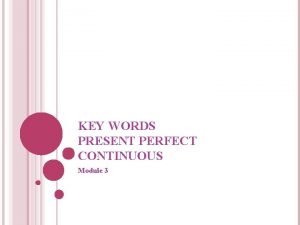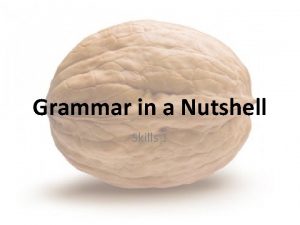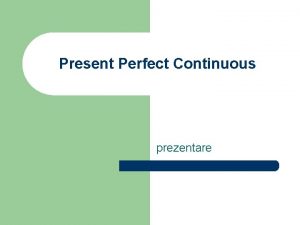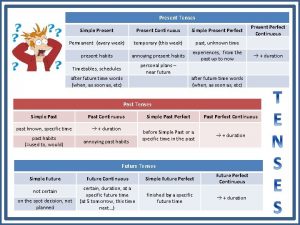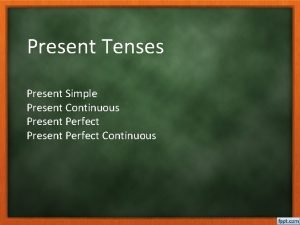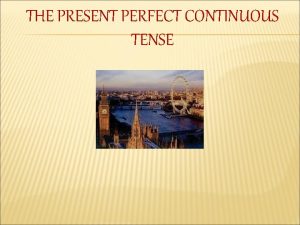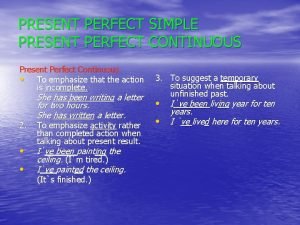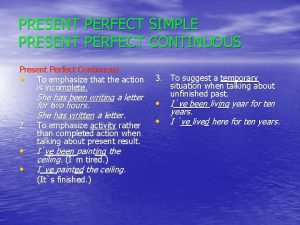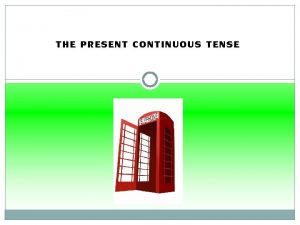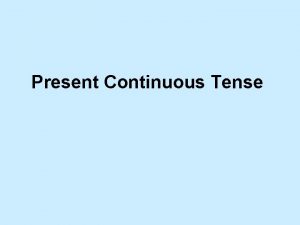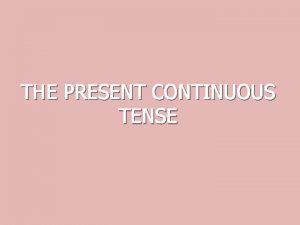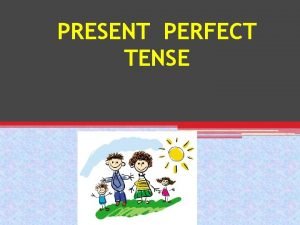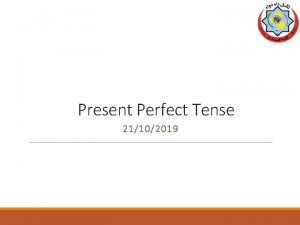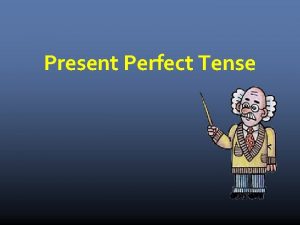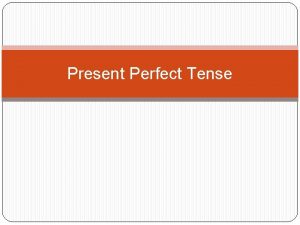Present Perfect vs Present Perfect Continuous Tense Lets


























- Slides: 26

Present Perfect vs. Present Perfect Continuous Tense Let’s review: -the forms of each -the difference in meaning between them

Present perfect = Present perfect Continuous The present perfect continuous is often very similar in meaning to the present perfect tense. • Just like the Present Perfect, we can use this grammar to talk about something that started in the past, and is still happening.

EXAMPLES I have lived in San Diego for 10 years. Meaning = I moved to San Diego 10 years ago and I still live here today. The Present Perfect connects the past and the present.

I have lived in San Diego for 10 years. I have been living in San Diego for 10 years. = I moved to San Diego 10 years ago and I still live here today.

Example: I have taught at ECC for many years. = I have been teaching at ECC for many years. - I have been learning English for many years. have learnt -In this case, both actions started in the past and continue up to the present time.

EXAMPLES I have been studying medicine for one year. OR I have studied medicine for one year. same meaning

4 -7 PRESENT PERFECT PROGRESSIVE vs. PRESENT PERFECT (i) I’ve been studying Spanish ever since I visited Mexico. OR I’ve studied Spanish ever since I visited Mexico. usual, habitual activities either tense okay

4 -7 PRESENT PERFECT PROGRESSIVE vs. PRESENT PERFECT (h) Rolf has been running every day since he was a child. OR Rolf has run every day since he was a child. usual, habitual activities either tense okay

WHEN ARE THEY DIFFERENT? Another common use of the Present Perfect is. . . To talk about recently finished actions (often with just) Example: Susan has just mopped the floor, so don’t walk on it! BUT Susan has been mopping the floor (means she hasn’t finished mopping it yet)

The Present Perfect Continuous Tense • But the present perfect continuous focuses more on the action. continuous The emphasis is on the duration of the action.

WHAT IS EMPHASIZED? Dee has been working for ten hours.

4 -6 PRESENT PERFECT PROGRESSIVE (a) Dee has been working since 6 o’clock. (b) She has been working for ten hours. STATEMENT: have/has + been + -ing

4 -6 PRESENT PERFECT PROGRESSIVE (c) How long has she been working? QUESTION FORM: have/has + subject + been + -ing

Example: It began raining two hours ago. It is STILL raining now. *It has been raining for two hours.

More Examples of P. P. Continuous: Jane started to work in her garden at 8: 00 this morning. Now it is 12: 00. She has been working in her garden for 4 hours! Wow! She must be tired now!

Where’s Kelly? She’s sleeping. She’s been sleeping for a long time. Sam and Paul are talking in the hallway. They have been talking since class ended.

Note! In English, we don’t usually use stative (non-action) verbs with continuous tenses. Example: Jean got a headache two hours ago. She still has a headache now. She has been having a headache for two hours. Because “have” is a stative verb, we don’t like to put it in continuous form; so instead, we use present perfect: Jean has had a headache for two hours.

IMPORTANT: we DON’T use the Present Perfect Continuous with stative (non-action) verbs; instead, we prefer to use the Present Perfect. Example: 1) I have been knowing Maria for many years. -INCORRECT 2) I have known Maria for Many years. -CORRECT

IMPORTANT: Present Perfect is often used for actions that were recently completed. We often use “just” in these cases. -Mark has just finished his English essay. 4. Present Perfect Continuous is preferred when we want to emphasize the duration of an action that is NOT YET FINISHED. -Mark has been studying for three hours!

BE CAREFUL! 4 -6 PRESENT PERFECT PROGRESSIVE Mary is playing the piano right now. PRESENT PROGRESSIVE in progress right now duration of time not mentioned Mary has been playing the piano right now.

4 -6 PRESENT PERFECT PROGRESSIVE (e) Mary has been playing since noon. (f) Mary has been playing for an hour. PRESENT PERFECT PROGRESSIVE began in past in progress right now time expressed Mary is playing the piano since noon.

4 -6 LET’S PRACTICE PRESENT PROGRESSIVE OR PRESENT PERFECT PROGRESSIVE use is using the phone. My sister _____ has been using it for three She _______ hours. I need to make a call.

4 -6 LET’S PRACTICE PRESENT PROGRESSIVE OR PRESENT PERFECT PROGRESSIVE go going Where are you _______for the summer holiday? going to the beach. I am ______ have been going to the beach I _______ every summer since I was a child.

4 -7 PRESENT PERFECT PROGRESSIVE vs. PRESENT PERFECT These guys are hiking. They have been hiking for several days.

4 -7 PRESENT PERFECT PROGRESSIVE vs. PRESENT PERFECT PROGRESSIVE (a) My cousin is hiking with his friends. They have been hiking for several days. duration of present activities, action verbs PRESENT PERFECT (b) My cousin has hiked many mountains. repeated activities unspecified times in the past

4 -7 PRESENT PERFECT PROGRESSIVE vs. PRESENT PERFECT (d) The guys have known each other for ten years. (e) INCORRECT: The guys have been knowing each other for ten years. duration of present activities, non-action verbs
 Czas present perfect tense
Czas present perfect tense Present perfect tense vs present perfect continuous tense
Present perfect tense vs present perfect continuous tense Past perfect continuous tense vs present perfect continuous
Past perfect continuous tense vs present perfect continuous Examples
Examples Past continuous or progressive
Past continuous or progressive Past perfect ejemplos
Past perfect ejemplos Verbs in present continuous tense
Verbs in present continuous tense Simple present tense vs present continuous tense exercise
Simple present tense vs present continuous tense exercise Verb tense review
Verb tense review Present perfect tense examples in hindi
Present perfect tense examples in hindi Present perfect continuous affirmative
Present perfect continuous affirmative Past simple vs present continuous
Past simple vs present continuous Present perfect continuous tense time expressions
Present perfect continuous tense time expressions Present perfect continuous tense key words
Present perfect continuous tense key words Present tenses
Present tenses Have been + ing
Have been + ing Present perfect tense examples
Present perfect tense examples I write a letter now past continuous tense
I write a letter now past continuous tense Present perfect present simple present continuous
Present perfect present simple present continuous Present perfect continuous passive
Present perfect continuous passive Present simple present continuous present perfect
Present simple present continuous present perfect Present simple present continuous and present perfect
Present simple present continuous and present perfect Present simple present continuous past simple
Present simple present continuous past simple Past continuous past perfect past perfect continuous
Past continuous past perfect past perfect continuous Future continuous and future perfect
Future continuous and future perfect Past continuous tense while
Past continuous tense while Site:slidetodoc.com
Site:slidetodoc.com


